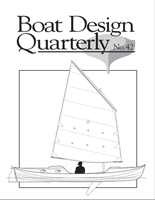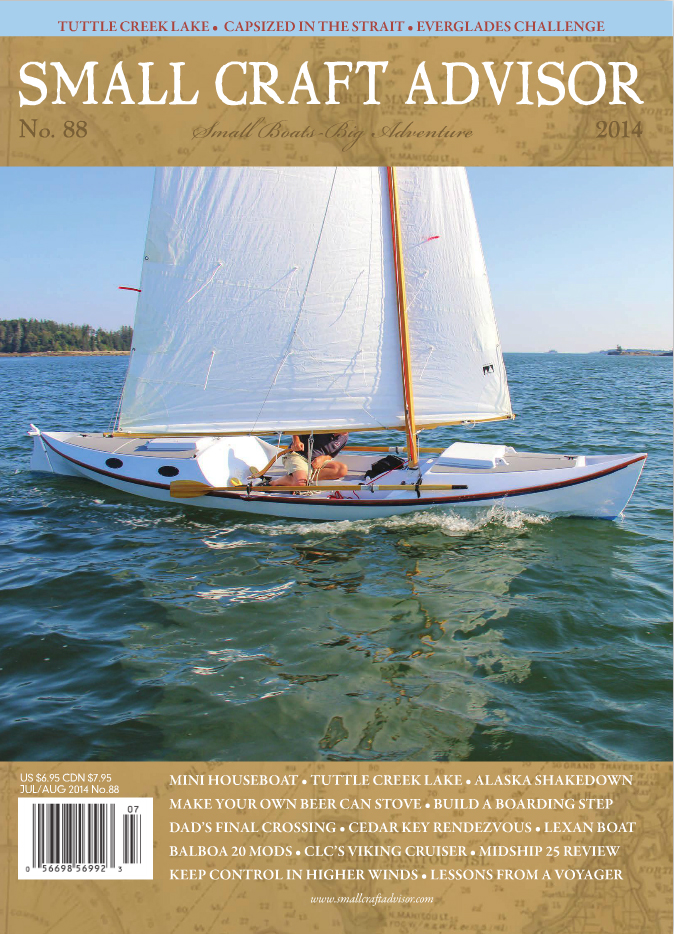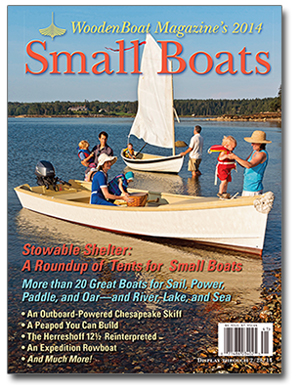
Faerings are the indigenous smallcraft of Scandinavia, direct descendants of the Viking ships that raided and traded throughout Europe starting more than a thousand years ago. Lightly but strongly built, the distinctive double-ended hulls feature a sweeping sheerline, lapstrake planking, and a narrow waterline for speed under oars and sail.
The old faerings---and the Viking ships, too---were built backwards from the methods that persisted in the Western World until recently: you build a frame, then cover in the frame with planking, lapstrake or otherwise. The Nordic boatbuilders understood that the planking itself could provide much of the strength. They planked their hulls first, then added frames as needed. This was lighter, among other things.
Tens of thousands of modern stitch-and-glue boats have been built the same way: pre-fabricated planks (of plywood, in this case) are joined at their edges with minimal framing to create a light, stiff, "monocoque" hull.
Putting two and two together, designer John C. Harris resolved that the elegant shape of the Norwegian faering would be a great fit for stitch-and-glue methods. A 19'8" beach cruising faering was designed, with four of them built. Unfortunately, the design was created on spec and there hasn't been time to create the elaborate illustrated instruction manual that would make construction accessible to amateurs.
The project languished, but along came a small-boat enthusiast who wanted a serious rowing and sailing boat for coastal work. Would CLC design and build such a boat for him? Of course we would, and we did.
Besides requirements that the boat have a sliding seat and a sailing rig, the owner also specified that camping accommodations be available under a hard deck. This was a bit of a puzzle, as it was difficult to work the geometry of a sliding seat into a boat with a cabin in the customary amidships location. Harris realized that the answer was at hand: a larger version of the Norwegian faering (known as a fembøring), often had a cabin located right aft. A stretch of the 19'8" stitch-and-glue CLC Faering to 22'6" would provide space for a sliding seat amidships, a small cuddy aft, and a sailing rig forward.

We were pretty excited by the early sketches, which suggested a boat that was both functional and stylish. We built the Faering Cruiser in about seven months of part-time work at CLC's Annapolis factory.
Hull, cockpit, and interior framing is mostly 9mm okoume. Decks are 6mm okoume. With parts machined on our CNC cutter, assembly was very quick---one day to glue up the puzzle joints in the hull panels, and one day to stitch everything together in the usual stitch-and-glue fashion. CLC's LapStitch™ process yields a hull that is stiff, light, beautiful, and quick to build.
While 22'6" of overall length sounds big, this is actually a fairly compact camp-cruiser, weighing only about 650lbs on the trailer. It tows effortlessly behind small cars.
Many curious people have eased into the "cabin" and the universal reaction is that it's comfortable, if cozy, similar to sleeping in a good one-man tent. The advantages over an open boat are that your gear and bedding stay dry no matter what the weather's doing, that the sealed compartment provides a great deal more safety in a capsize, and that you have lockable stowage.
Several rig options were considered before settling on a single balanced lug sail. On paper the sail area is modest, but the hull is very easily driven. The boat is fast, jumping up to 6 knots in 12 knots of wind. 270lbs of water ballast beneath the self-bailing cockpit floor settles the boat right down, though a reef is needed once whitecaps appear unless you're trying to win a race. The pivoting centerboard allows nice balance and excellent upwind ability. The rudder is connected to the tiller with stainless steel cables that run through baffled vents in the cabin (no leaks to worry about). Flipping the tiller up locks the rudder on the centerline for rowing.
With a sliding seat and long sculls, a rower of modest strength and middling ability can move the boat upwind easily enough, although you're likely to be sailing if there's a long way to go to windward. In a flat calm, it's easy to imagine a 25-mile day under oars alone. We might consider eliminating the sliding-seat option and using shorter oars with a fixed seat. Speed would suffer a little, but there would be no need to stow a sliding seat and oar storage would be improved. Lazy jacks lift furled boom and yard to clear the cockpit for rowing. A tabernacle scheme for lowering the mast is suggested, but it's fairly complex and will add weight.
As a coastal cruiser, this design offers many advantages---a dry berth, lots of storage, and excellent speed under sail and oars. We suspect that many builders would be moving up to this design from kayaks or small rowing boats, seeking more comfort and stowage while maintaining a small footprint on the coastal trail.
Please click on "view contents" in the boxes above for details on the kits and plans.
The Faering Cruiser design was featured in Boat Design Quarterly, Small Craft Advisor, WoodenBoat's Small Boats annual, Classic Boat, Watercraft, and others.


